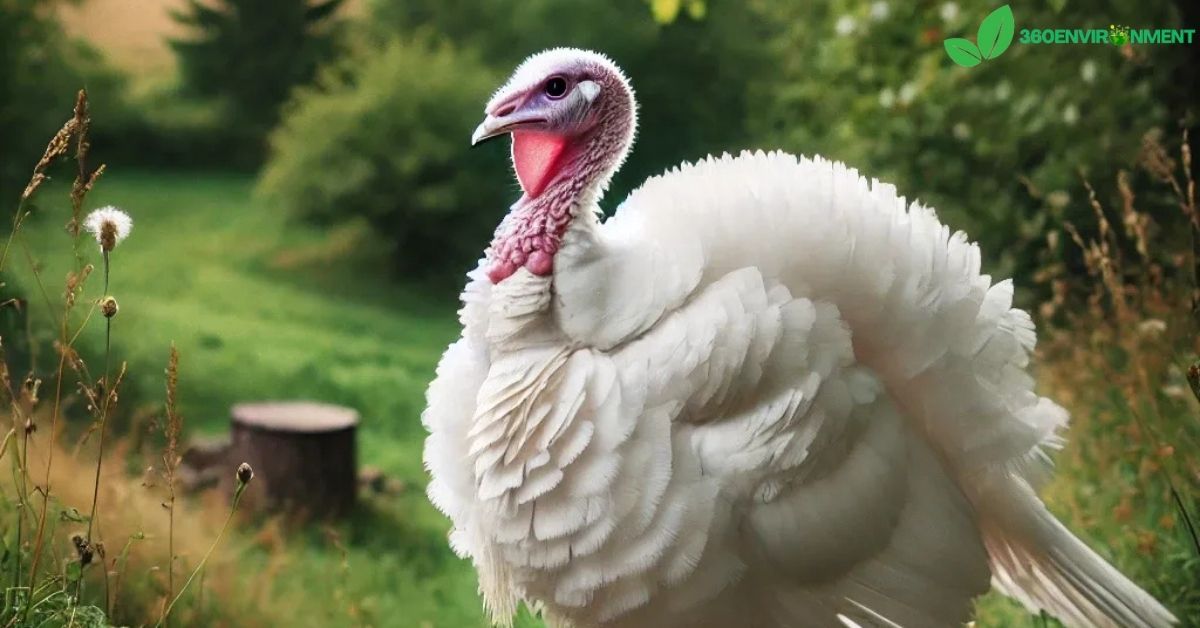Turkeys are widely recognized for their significance in both wildlife and domesticated agriculture, with their role in ecosystems and human food production being well-established. Among these birds, however, a rare and captivating genetic anomaly occurs: the albino turkey. Albino animals have always fascinated scientists and nature enthusiasts due to their unique appearance and the challenges they face in the wild. An albino turkey stands out for its striking all-white feathers and lack of pigmentation, offering an opportunity to explore both the biological aspects of albinism and its environmental implications.
In this article, we will explore the phenomenon of the albino turkey, delving into its biology, the challenges albino animals face in the wild, their role in ecosystems, and their broader environmental significance. Additionally, we will discuss conservation efforts to protect these rare birds and how albinism affects various wildlife populations.
1. What Is Albinism?
To understand the albino turkey, it is important first to define albinism. Albinism is a genetic condition that results in the absence of melanin, the pigment responsible for coloring the skin, eyes, and feathers of birds and other animals. Albinism occurs when there is a mutation in the genes that control the production of melanin. As a result, albino animals have white or very light-colored skin, feathers, or fur, and their eyes are often light blue or pink due to the lack of pigment.
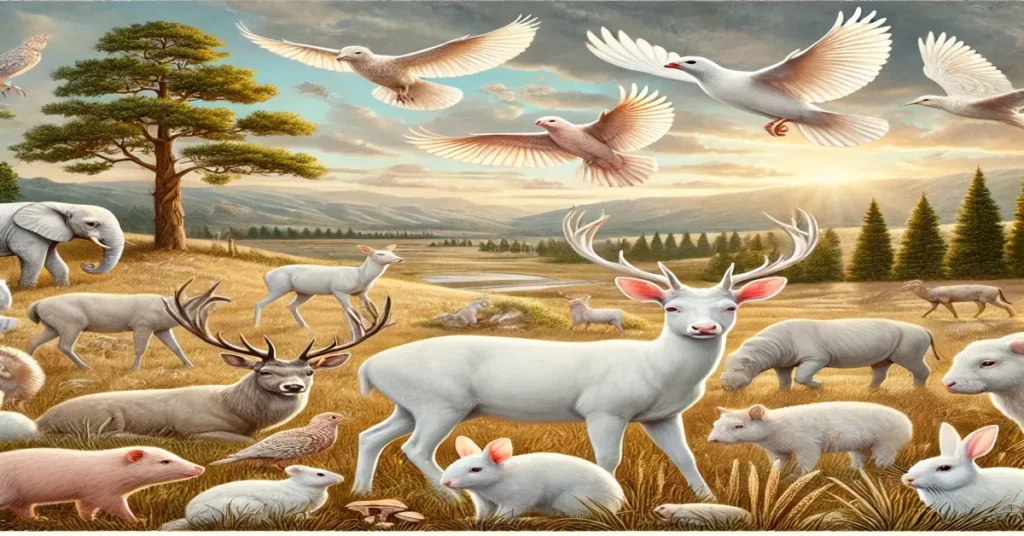
1.1. The Genetics of Albinism
Albinism is caused by a recessive genetic mutation. For an animal to be albino, it must inherit two copies of the mutated gene—one from each parent. This makes albinism a relatively rare condition, as both parents must carry the gene for it to manifest in their offspring.
In turkeys, as in other animals, albinism is characterized by:
- White feathers: Due to the lack of melanin, albino turkeys have completely white feathers.
- Pink or light blue eyes: The absence of pigment in the eyes causes them to appear pink, red, or light blue, as the color comes from blood vessels visible through the iris.
- Sensitive skin: Albino animals often have more sensitive skin and are more prone to sunburn due to the lack of protective pigmentation.
Though the occurrence of an albino turkey is rare, it can occur in both wild and domesticated populations, making them a unique subject for study in terms of genetics and animal behavior.
2. Albino Turkey: Appearance and Identification
The most distinctive feature of an albino turkey is its lack of pigmentation. While wild turkeys typically have dark, brownish-black feathers that help them blend into their forested surroundings, an albino turkey will be entirely white, making it stand out dramatically in the wild.
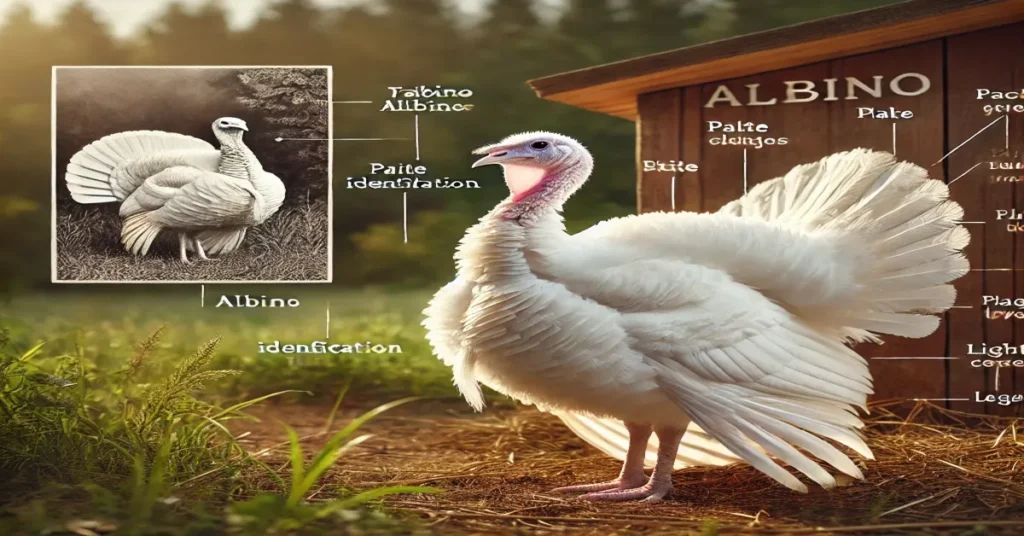
2.1. Physical Characteristics
Albino turkeys possess the following key physical traits:
- Feather coloration: All feathers on an albino turkey are white, without any of the typical dark iridescence seen in wild turkeys.
- Eye color: The eyes of an albino turkey are pink or pale blue, often giving the bird a ghostly appearance.
- Skin and beak: The skin on an albino turkey’s head and neck will also lack pigmentation, appearing pale or pink rather than the usual darker color.
While albino turkeys share the same general body structure as non-albino turkeys, the absence of melanin makes them extremely vulnerable in natural environments.
3. The Challenges Faced by Albino Turkeys in the Wild
While the appearance of an albino turkey is striking, their lack of pigmentation can create several challenges that affect their survival. In the wild, melanin serves many functions beyond just providing color, including protection from ultraviolet (UV) radiation and aiding in camouflage. For an albino turkey, these vital benefits are lost, making survival in the wild more difficult.
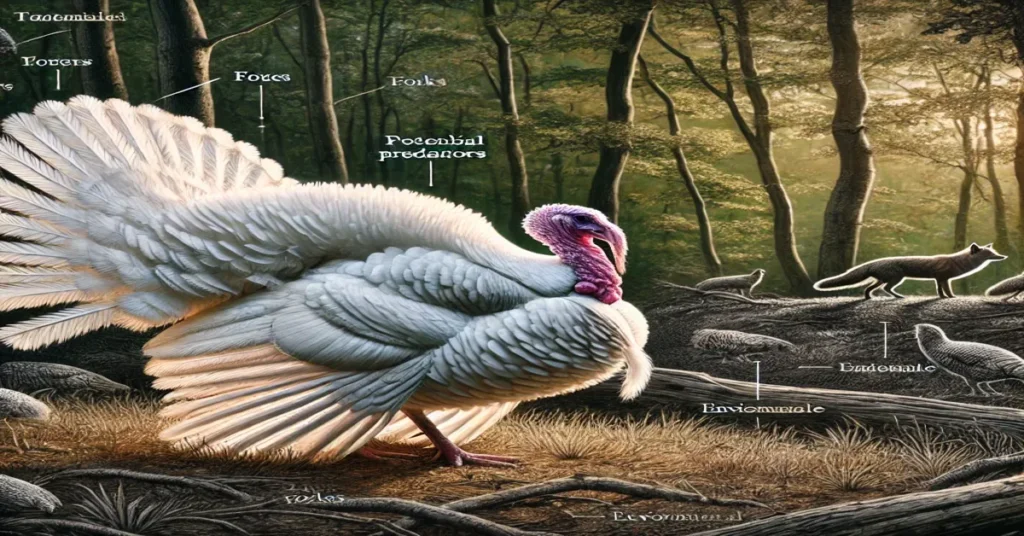
3.1. Lack of Camouflage
One of the most significant challenges for an albino turkey in the wild is the inability to camouflage itself. The typical brown, iridescent feathers of a wild turkey allow it to blend into the forest floor, helping it avoid predators such as foxes, coyotes, and birds of prey. However, the bright white feathers of an albino turkey make it much more visible to predators, reducing its chances of survival.
In many cases, this lack of camouflage means that albino animals are more vulnerable to predation, particularly when they are young and unable to escape as easily.
3.2. Sun Sensitivity and Health Risks
The absence of melanin also means that albino turkeys are more susceptible to damage from UV radiation. In wild turkeys, melanin in the feathers and skin offers protection from the sun’s harmful rays. Without this pigment, albino turkeys are more prone to sunburn and skin damage, which can lead to infections and other health complications.
Additionally, albinism is sometimes associated with other genetic health problems, such as poor eyesight. Albino animals often have reduced visual acuity, which can make it difficult for them to locate food or avoid predators.
4. The Role of Albino Turkeys in Ecosystems
Despite the challenges they face, albino turkeys can play a unique role in ecosystems. In certain cases, their presence may help highlight important aspects of genetic diversity and how it contributes to the overall health of wildlife populations.
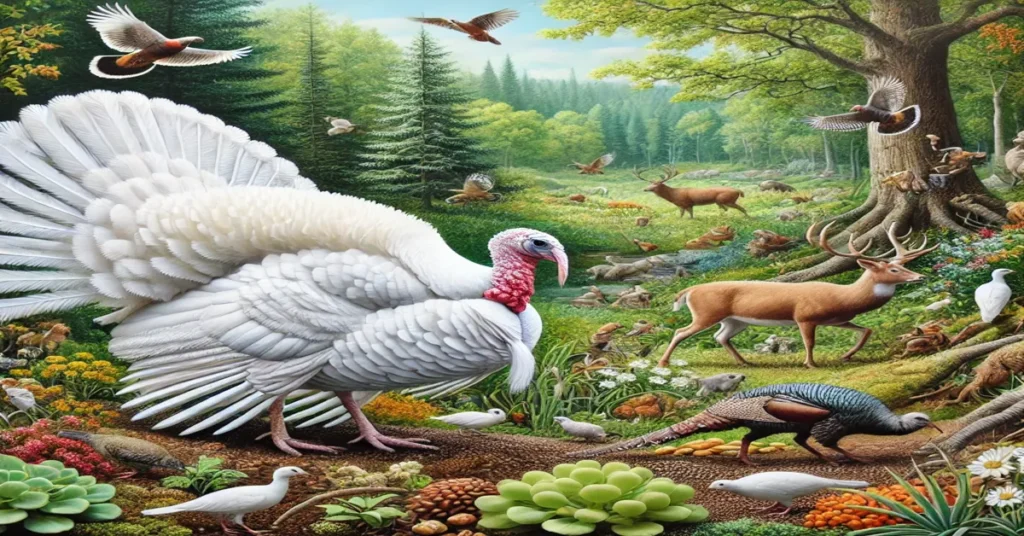
4.1. Genetic Diversity in Turkey Populations
The occurrence of albinism in turkeys is a rare but natural example of genetic diversity within a population. Genetic diversity is crucial for the resilience of species, as it allows populations to adapt to changing environmental conditions, resist diseases, and maintain healthy reproduction rates. The appearance of albino individuals, while uncommon, serves as a reminder of the genetic variability present in natural populations.
In the context of turkey populations, albino turkeys represent an unusual expression of genetic diversity. While they are less likely to survive in the wild due to their vulnerability, their presence indicates that the turkey population carries a broad range of genetic traits, which can be beneficial for the species’ long-term survival.
4.2. Ecological Impact of Predation
Albino turkeys may also play an indirect role in their ecosystems by affecting predator-prey dynamics. Because albino turkeys are more visible to predators, they may be more frequently targeted, which could slightly reduce predation pressure on other, better-camouflaged turkeys.
This phenomenon could have a small but measurable impact on local predator populations. Predators may focus on hunting the more visible albino turkeys, giving other turkeys in the area a greater chance to evade capture and contribute to the overall population.
5. Conservation and Protection of Albino Turkeys
While albino turkeys are rare, their protection is often tied to broader efforts to conserve turkey populations in general. Conservation measures aimed at protecting wild turkeys can also benefit albino individuals, ensuring that they have a greater chance of survival in the wild.

5.1. Habitat Conservation
The key to conserving wild turkey populations, including albino turkeys, is preserving their natural habitats. Wild turkeys rely on a mix of forests, grasslands, and wetlands to find food, shelter, and nesting sites. By protecting and restoring these habitats, conservationists can ensure that wild turkeys have access to the resources they need to thrive.
Habitat conservation efforts may include:
- Restoring native vegetation: Reforestation and the restoration of grasslands help provide essential food sources and cover for turkeys.
- Protecting wetlands: Wetlands are crucial for turkey populations, providing water, food, and habitat for both turkeys and their prey.
5.2. Protecting Genetic Diversity
Efforts to protect the genetic diversity of wildlife populations are also essential for the conservation of rare genetic traits like albinism. While albino turkeys may be less likely to survive in the wild, they still represent an important part of the genetic makeup of the species. Maintaining healthy turkey populations with a broad genetic pool ensures that the species can adapt to environmental changes and resist diseases.
Conservation programs focused on preserving genetic diversity may involve:
- Managing hunting practices: Regulating hunting seasons and limits helps prevent the overharvesting of wild turkeys, ensuring that populations remain robust and genetically diverse.
- Supporting captive breeding programs: In some cases, captive breeding programs can help preserve rare genetic traits, such as albinism, within a controlled environment.
6. Albino Turkeys in Captivity and Domestication
While albino turkeys are rare in the wild, they are sometimes found in captivity, particularly in domesticated turkey populations. Domesticated turkeys are often bred for specific traits, and while albinism is not typically selected for, it can still occur naturally in breeding operations.

6.1. Albino Turkeys in Farming
In commercial turkey farming, albinism is not a sought-after trait. Most farmers prefer turkeys with healthy pigmentation, as these birds are better suited to outdoor environments and are less prone to the health risks associated with albinism. However, albino turkeys may occasionally appear in farming operations, where they are typically kept under controlled conditions to minimize the risks associated with sun exposure and predation.
6.2. Albino Turkeys as Pets or Ornamental Birds
In some cases, albino turkeys are kept as pets or ornamental birds due to their striking appearance. These birds are typically kept in more sheltered environments, where their sensitivity to sunlight and their visibility to predators are less of an issue.
However, keeping a turkey as a pet or ornamental bird requires special care, as these birds are more sensitive to environmental factors than their pigmented counterparts. Owners must provide protection from direct sunlight to prevent sunburn and ensure that turkeys are housed in secure enclosures to keep them safe from predators. In captivity, turkeys can live relatively healthy lives as long as they receive proper care and attention to their specific needs.
6.3. Health Concerns in Captive Albino Turkeys
While turkeys can live in captivity, they are prone to certain health issues due to their lack of pigmentation. These health concerns include:
- Vision Problems: Many albino animals suffer from poor eyesight, which can make it difficult for albino turkeys to navigate their surroundings or find food. In captivity, owners must ensure that albino turkeys have easy access to food and water to avoid unnecessary strain on their vision.
- Skin Sensitivity: As mentioned earlier, turkeys are more vulnerable to sunburn and skin damage. In captive environments, it is essential to provide adequate shade and protection from the sun, especially during hot summer months.
- Weakened Immune System: Albinism can sometimes be associated with a weakened immune system, making turkeys more susceptible to infections and diseases. Regular veterinary checkups and maintaining a clean living environment can help mitigate these risks.
7. The Rarity of Albino Turkeys: Conservation Significance and Awareness
While albinism in turkeys is rare, the presence of albino turkeys serves as an important reminder of the biodiversity and genetic variability that exists within species. Efforts to protect turkeys, along with other animals that exhibit unique genetic traits, highlight the importance of maintaining diverse and healthy wildlife populations.

7.1. Raising Awareness About Albinism in Wildlife
Albinism is a rare condition in wildlife, and animals like the albino turkey are often the subject of fascination and curiosity. Raising awareness about albinism and its effects on wildlife can help foster greater appreciation for biodiversity and the challenges that animals face in the wild.
By educating the public about the ecological significance of albinism, conservationists can promote a deeper understanding of genetic diversity and encourage support for efforts to protect rare and endangered species, including those with unique genetic traits like albinism.
7.2. Conservation of Rare Genetic Traits
Conserving the genetic diversity of species is essential for ensuring the long-term survival of wildlife populations. Albino turkeys, while rare, represent a valuable part of the genetic makeup of turkey populations. Efforts to protect turkey habitats, regulate hunting, and maintain healthy population levels help safeguard this genetic diversity, ensuring that rare traits like albinism can continue to occur naturally in the wild.
8. Conclusion: The Unique Importance of the Albino Turkey
The albino turkey is a rare and fascinating example of genetic diversity in nature. While albinism presents significant challenges for survival in the wild, turkeys serve as an important reminder of the variability that exists within species. These birds face unique challenges, such as increased vulnerability to predators and sun sensitivity, but they also contribute to our understanding of genetics, biodiversity, and the resilience of wildlife populations.
As we continue to explore the environmental significance of albino animals like the turkey, it is essential to recognize the broader implications for conservation. Protecting the habitats and genetic diversity of wild turkeys, along with other species, ensures that rare traits like albinism can persist in natural ecosystems. Conservation efforts aimed at preserving genetic variability and promoting biodiversity are critical for the long-term health of wildlife populations.
In summary, albino turkeys may be rare, but they represent a valuable part of the natural world. Their striking appearance, combined with the challenges they face in the wild, makes them a compelling subject for further study and conservation efforts. By protecting these unique individuals and their habitats, we contribute to the broader goal of preserving the incredible diversity of life on Earth.
FAQs
- What causes albinism in turkeys?
Albinism in turkeys is caused by a genetic mutation that prevents the production of melanin, the pigment responsible for coloring skin, feathers, and eyes. - How common are albino turkeys in the wild?
Albino turkeys are extremely rare in the wild due to the recessive nature of the gene responsible for albinism and the challenges albino animals face in terms of survival. - Can albino turkeys survive in the wild?
While albino turkeys can survive in the wild, they face several challenges, including increased vulnerability to predators and a higher risk of sunburn and other health issues. - Do albino turkeys have the same behavior as regular turkeys?
Yes, albino turkeys behave similarly to regular turkeys, but they may have poor eyesight and be more sensitive to sunlight due to their lack of melanin. - Are albino turkeys protected under conservation laws?
While albino turkeys are not specifically protected under conservation laws, efforts to conserve wild turkey populations help ensure that albino individuals have a greater chance of survival. - Can albino turkeys be kept as pets?
Yes, albino turkeys can be kept as pets, but they require special care due to their sensitivity to sunlight and potential health issues.
Read More: The Food Web of Rainforest: A Complex Network of Life

